9 /10 1 Votes
8.7/10 IGN Director(s) Toshiaki Suzuki Composer(s) Koji KondoAsuka Ohta | 4.6/5 Emuparadise 4.6/5 eBay Writer(s) Aya KyogokuDaiji Imai Initial release date 18 March 2004 | |||||||||||||||||||||||||||||||||
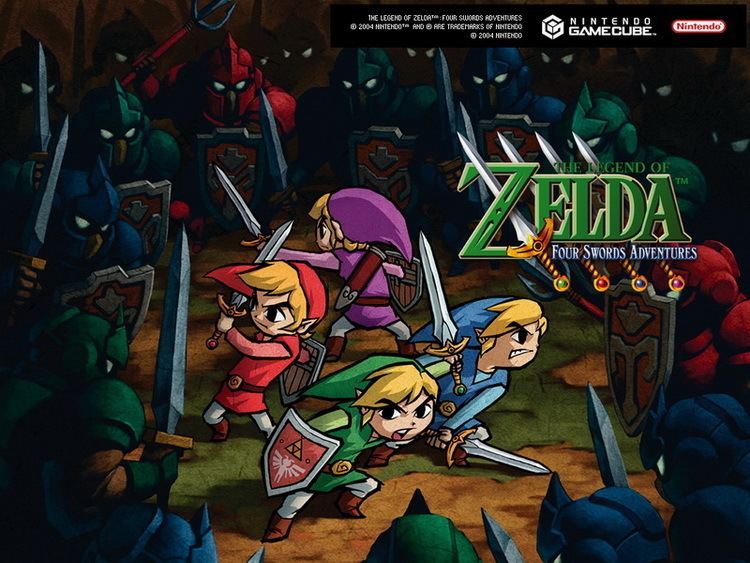 | ||||||||||||||||||||||||||||||||||
Producer(s) Shigeru MiyamotoEiji Aonuma Developers Nintendo, Nintendo Entertainment Analysis & Development Similar The Legend of Zelda: A, The Legend of Zelda: Th, The Legend of Zelda: Th, The Legend of Zelda: Or, The Legend of Zelda: A | ||||||||||||||||||||||||||||||||||
The legend of zelda four swords adventures tetra s trackers
The Legend of Zelda: Four Swords Adventures is the eleventh installment in Nintendo's The Legend of Zelda series. It was released for the Nintendo GameCube home video game console in Japan on March 18, 2004; in North America on June 7, 2004; in Europe on January 7, 2005; and in Australia on April 7, 2005. The Game Boy Advance handheld game console can be used as a controller when using the Nintendo GameCube – Game Boy Advance link cable bundled with the game in North America and Europe. The game is fully compatible with the Nintendo Wii including the use of the Game Boy Advance Link Cables.
Contents
- The legend of zelda four swords adventures tetra s trackers
- The legend of zelda four swords adventures episode 34 finale
- Gameplay
- Hyrulean Adventure
- Shadow Battle
- Navi Trackers
- Plot
- Development
- Reception
- References
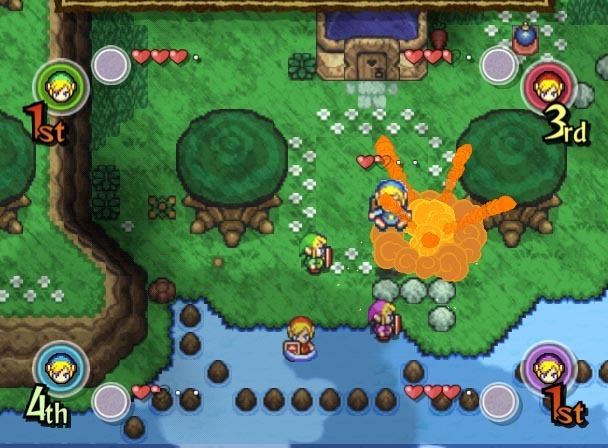
The game takes Link on an adventure to restore peace to Hyrule after learning that an evil counterpart of himself, Shadow Link, has been created. Four Swords Adventures was considered the 48th-best game ever made for a Nintendo system by Nintendo Power, and received an aggregated 86 out of 100 from Metacritic. It was the third best-selling game of June 2004 in North America, with 155,000 units, and has since sold 250,000 copies; it has also sold 127,000 units in Japan.
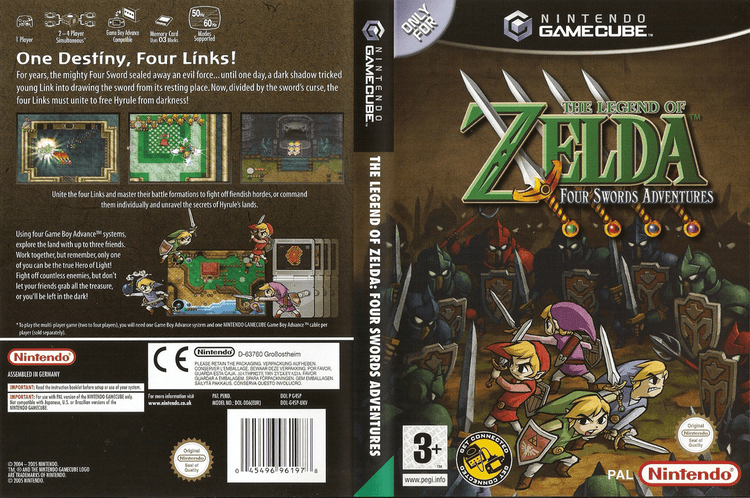
The legend of zelda four swords adventures episode 34 finale
Gameplay
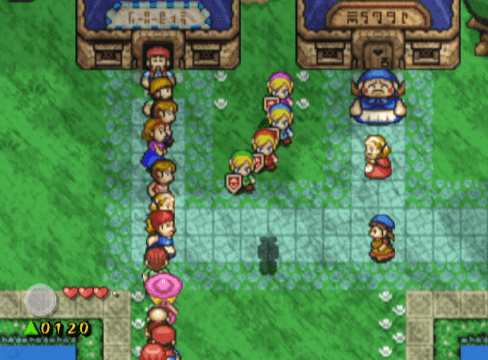
The main mode of Four Swords Adventures is "Hyrulean Adventure", an episodic, cooperative multiplayer adaptation of conventional The Legend of Zelda gameplay. "Shadow Battle" is a competitive multiplayer battle mode. "Navi Trackers", present only in the Japanese version of the game (and displayed briefly at E3 before the US release), is a multiplayer stamp rally race.
Hyrulean Adventure
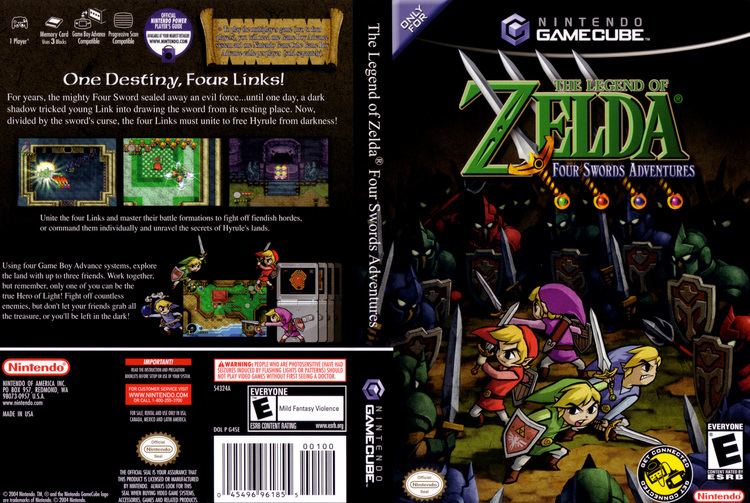
Hyrulean Adventure is the main campaign of Four Swords Adventures, and can be played by one to four players. It consists of eight worlds, each with three stages and a boss battle. The graphics are similar to that of the Game Boy Advance version, but the maps are static rather than randomly generated, the top-down view is taken from The Legend of Zelda: A Link to the Past, and gameplay includes effects from The Wind Waker. The graphics also include enhanced atmospheric effects such as cloud shadows that slowly move across the ground, heat shimmer, dust storms, and fog. Music is based on that of A Link to the Past, but is rearranged in places.

In Hyrulean Adventure, most of the same mechanics as the previously released Four Swords for the Game Boy Advance (GBA) are used. The multiplayer version requires each player to have a GBA, which is used as a controller and to which the action transfers when that player's character goes off the main screen, but the single player game may be played with either a GameCube controller or a GBA. There are always four Link characters (differentiated by different colors: green, red, blue and purple) in play, regardless of the number of people playing; "extra" Links are attached to those directly controlled and positioned around the controlling character. Normally, the extra Links follow the player, but players can separate an individual Link and control independently, or put the four Links into formations. These techniques are required to solve puzzles and defeat enemies. Players are encouraged to work together to gather enough Force Gems to empower the Four Sword, and failing to do so by the time the boss is defeated or the dark barrier is reached results in having to go back to the beginning of the stage to collect more. However, once the requisite gems are collected, players are automatically transported to the dark barrier and therefore do not have to repeat the entire stage.
Players can play minigames in multiplayer mode at Tingle's Tower, which appears in every world, to gain extra multiplayer lives. These eight games are earned by playing though certain stages in multiplayer mode. The minigames include horse racing, hammer tag, monster hunting and five others.
Shadow Battle
In Shadow Battle, two or more players battle each other until only one is left standing. As in Hyrulean Adventure, each player uses a different-colored Link character and wields various tools to attack the other Links. Initially, there are five stages which players can choose as the battle's arena. Five bonus maps are unlocked upon completion of Hyrulean Adventure (these "dark stages" are almost the same as the first five maps, but portals to the dark world appear and the player has limited vision). In each stage, items randomly appear, and are usually similar to the items in Hyrulean Adventure. There are many special objects in each stage, which can be used to the player's advantage. There is also a time limit; when it reaches zero, the game is tied.
Navi Trackers
Navi Trackers (formerly planned as a stand-alone game titled Tetra's Trackers) is a game only present in the Japanese version of Four Swords Adventures (Four Swords +). In this game, multiple players use a combination of the television screen and Game Boy Advances to search for members of Tetra's pirate crew to gain as many stamps as possible within a given time limit. Action takes place on the Game Boy Advance used by each player, with the television screen showing a basic map and Tetra narrating the action. A single-player mode is also available, which allows players to either collect alone or compete against Tingle.
Plot
The game begins with the land of Hyrule in a state of fear because of strange happenings that have occurred recently. On a stormy night, Princess Zelda and the shrine maidens fear that the reason for these events is that Vaati's seal is weakening. She summons Link and brings him to the castle so he can protect her and the other maidens while they open the portal to the Four Sword Sanctuary. When they do, however, a shadowy figure appears from the portal. This figure was Shadow Link, who then kidnapped the maidens of the Shrines and sealed them inside their crystals. Link follows him to the mysterious sanctuary where the Four Sword lies in the Pedestal, keeping the great evil sealed away. Suddenly, Link pulls the Four Sword out of its Pedestal, splitting into three clones of himself to destroy this doppelganger. However, The Seal that imprisoned the Sorcerer of Winds, Vaati, was broken and had released him from his Prison once again, wreaking havoc on the once peaceful kingdom of Hyrule and bringing chaos and horror.
As Link and his clones wander the overworld of Hyrule Field on their quest to restore peace to Hyrule, they learn that the creation of Link's evil counterpart and the release of Vaati is only a small part in an insidious plot to take control of Hyrule. Things complicate as the dimension of the Dark World appears and people are being abducted throughout Hyrule. Four Links learn that not only have the knights of Hyrule mysteriously disappeared, but evil versions of them have been creating havoc. Hyrule castle has been taken over and monsters are appearing everywhere. Four Links agree that they will defeat Vaati, and then rescue Zelda to restore peace to Hyrule.
It is revealed later in the game that the true villain is Ganon, King of Darkness. He has stolen a powerful trident and used it to take control of parts of Hyrule. Unfortunately, he stole the dark mirror and used it to create Shadow Link and then sent him to kidnap the shrine maidens and trick Link into releasing Vaati. In order to gain as much power as possible and build up his army, Ganon wants to take control of the shrine maidens' power as well as abducting people and sending them into the Dark World where they would become part of his army. Vaati unknowingly furthered his plans by creating monsters to add to his army. It is revealed that the Knights of Hyrule were murdered by Ganon and their souls were trapped in the World of Darkness where they became creatures of Darkness. Four Links eventually save the shrine maidens, retrieve the Dark Mirror, destroy Shadow Link and Vaati, and face Ganon in a final battle. Trying to stop him from plunging the world into chaos, four Links use the Power of the Maidens of Shrines, Including Zelda, to defeat Ganon, penetrating him. As he was about to become sealed inside, he declared: "I cannot be destroyed by insects of you! Noooo!!!"
After penetrating Ganon, Four Links firmly seal him inside the Four Sword, bringing chaos and horror to an end. Peace returns to Hyrule, souls of the knights are freed from their torment, and the people celebrate as all traces of evil that plagued Hyrule are vanquished. With Ganon defeated and sealed inside, Link returns the Four Sword that sealed darkness away back to its resting pedestal and the Four Links become one again. After the battle, The Maidens of the Shrine use their powers and create a barrier, which is strong enough for the Four Sword to rest before the six maidens leave. Thus, his journey has ended and both of them leave the Sanctuary as Darkness fades away and Light endures in the Land of Hyrule, bringing peace and prosperity.
Development
At E3 2003, Nintendo showcased two Zelda games which would make use of the Game Boy Advance connectivity, Four Swords and Tetra's Trackers. In December of the same year, it was announced that both games would be together in a single disc, Four Swords +, along with a third, Shadow Battle. Four Swords Adventures was released in Japan with Hyrule Adventure, Shadow Battle, and Navi's Trackers as three individual games bundled together. It was later announced on June 7, 2004, however, that Hyrule Adventures and Navi's Trackers would be sold as two separate titles in the United States, while the retail status of Shadow Battle was still unknown. This decision was later changed to bundle Hyrule Adventure with Shadow Battle, and to not release Navi's Trackers in the United States.
Despite the fact that translations for the PAL version were finished in October, the game was not released in Europe until early January 2005. A possible reason for this is so that the game did not compete with The Minish Cap for sales, which in turn was released pre-Christmas in Europe because, unlike North America, it would not cannibalize Nintendo DS sales.
Early on the development of Navi Trackers, it was decided that it would include a speech navigation system that talks and advises the player during mini-games. Players type in their name and the system calls players by their name during the game in order to notify them of their turn.
Reception
In 2006, Nintendo Power rated Four Swords Adventures the 48th best game made on a Nintendo system. It received a score of 86 out of 100 based on 55 aggregated reviews from Metacritic, and an average score of 85% based on 67 reviews from GameRankings.
GameSpot praised the game's connectivity feature with the Game Boy Advance, claiming that this is "a truly compelling reason to invest in a GameCube-to-GBA link cable" and that "using the Game Boy Advance as a controller has an appreciable impact on the experience". They also praised the story and said, "One of the differences between the original Four Swords and Adventures is a more persistent narrative." The game was also applauded, with a critic quoted as remarking, "Adventures does improve on the original Four Swords' visuals, making the Wind-Waker-derived visual style even more reminiscent of the cel-shaded adventure of Link." The audio was noted, with a review remarking, "The sound design for Four Swords Adventures will be even more familiar to anyone who has played any Zelda game, and especially to those who have played The Wind Waker."
Four Swords Adventures also received criticism. Game Revolution said about the game, "Graphically, Four Swords Adventures is an odd mix of cheap 2D SNES sprites and nice Gamecube particle effects. It looks a lot like the GBA game, but now wears fancier pants and shows off upgraded visual flourishes, like Wind Waker style curly-Q air poofs. Still, much of the technology has clearly been ported over from the GBA, creating an inconsistent feel." They also criticized the requirement of the link cable, saying that "the required use of the GBA for multiplayer does limit the play potential."
Four Swords Adventures was the third best-selling game of June 2004 in North America with 155,000 units, and has since sold 250,000 copies, becoming a part of the Player's Choice line. The game also sold 127,000 units in Japan.
A manga novelization of the game was authored by Akira Himekawa. In it, each of the four Links have a distinct personality: the Link in green (nicknamed "Green") acted similarly to his normal self, focused and brave, the Link in red ("Red") was portrayed as a childish optimist, the one in blue ("Blue") was quick-tempered and aggressive, and the one in violet ("Vio") was aloof and self-possessive. This of course caused the four Links to argue among one another due to their conflicting personas. The four decided to use nicknames of the color they are wearing so they would not confuse each other.
